Abstract
The brightness of bleached bamboo chemo-mechanical pulp (CMP) is often too low to be used as a furnish in value-added paper products. In this study, preliminary optimization of various parameters of a modified hydrogen peroxide (H2O2) bleaching procedure for bamboo CMP pulps was performed using the inclusion of ethanol in the bleaching medium (IEBM). Compared with a conventional bleaching method, this modified process is aimed at improving bleaching efficiency and brightness ceiling of bamboo CMP with the proper usage of chemicals. The CMP was bleached to a brightness of 74.2% ISO at the usage level of 12% H2O2, which shows it increased by 7.4% ISO compared with the conventional method. For a brightness target of 72.0% ISO, bleaching with the IEBM method reduced the H2O2 consumption by approximately 60%. In addition, a higher activation energy of H2O2 for the IEBM method was calculated to be 23.3 kJ/mol, which was increased by 3.3 kJ/mol compared with the conventional method.
Download PDF
Full Article
Modified Hydrogen Peroxide Bleaching of Bamboo Chemo-mechanical Pulp Using Aqueous Alcohol Media
Fangmin Liang,* Guigan Fang,* Jian Jiao,* Yongjun Deng, Shanming Han, Hongbin Li, Qingwen Tian, Aixiang Pan, and Beiping Zhu
The brightness of bleached bamboo chemo-mechanical pulp (CMP) is often too low to be used as a furnish in value-added paper products. In this study, preliminary optimization of various parameters of a modified hydrogen peroxide (H2O2) bleaching procedure for bamboo CMP pulps was performed using the inclusion of ethanol in the bleaching medium (IEBM). Compared with a conventional bleaching method, this modified process is aimed at improving bleaching efficiency and brightness ceiling of bamboo CMP with the proper usage of chemicals. The CMP was bleached to a brightness of 74.2% ISO at the usage level of 12% H2O2, which shows it increased by 7.4% ISO compared with the conventional method. For a brightness target of 72.0% ISO, bleaching with the IEBM method reduced the H2O2 consumption by approximately 60%. In addition, a higher activation energy of H2O2 for the IEBM method was calculated to be 23.3 kJ/mol, which was increased by 3.3 kJ/mol compared with the conventional method.
Keywords: Bamboo; Hydrogen peroxide; Chemo-mechanical pulp; Bleaching
Contact information: Institute of Chemical Industry of Forest Products, CAF, National Engineering Laboratory for Biomass Chemical Utilization, Key Laboratory of Forest Chemical Engineering, SFA, Key Laboratory of Biomass Energy and Material, Nanjing 210042, P. R. China; Collaborative Innovation Center for High Efficiency Processing and Utilization of Forestry Resources, Nanjing Forestry University, Nanjing 210037, P. R. China; Institute of New Technology of Forestry, CAF, Beijing 100091, P. R. China; * Corresponding author: fangguigan@icifp.cn; samueljoe@163.com
INTRODUCTION
Earlier studies demonstrated that bamboo mechanical pulps are difficult to bleach and, at a given H2O2 dosage, their achievable brightness level is much lower than that of wood fiber (Shen et al. 2010; Liang et al. 2017). To produce high brightness bamboo pulps using economical levels of H2O2 charge, it is important to choose appropriate bleaching conditions based on the characteristics of bamboo fibers. Although the fundamentals of bamboo mechanical pulping and bleaching are not well documented, it is widely recognized that bamboo is different from wood (Chen 2010).
Hydrogen peroxide bleaching is the predominant bleaching method used in the manufacturing process of mechanical pulping (Pan 2001; Wójciak et al. 2007; Li et al. 2015) because it is the most effective and practical bleach chemical available in the industry (Xu 2000), such as bleached chemo-thermomechanical pulp (BCTMP). The process results in not just a brightness increase, but also helps in the development of pulp physical properties (Pan 2004; Ni et al. 2007). The bleaching operation contributes to the total cost. Therefore, there is an interest in improving the peroxide bleaching process to improve the economy of bleached mechanical pulp production.
Hydrogen peroxide bleaching, however, is affected by critical limitations in terms of efficiency and selectivity, which cannot be overcome in a conventional manner. Bleaching efficiency is expressed by decoloration number (DC) (Loras 1981). Hydrogen peroxide bleaching has a typical profile of brightness development having dependence on bleaching chemical consumption (Pan 2011). Initially, with an increasing H2O2 dosage coupled with a proper amount of alkali, the gain in brightness is rapid. The brightness rise slows down and finally reaches a plateau, which is called the brightness ceiling (Bajpai et al. 1994). To find more effective ways to surpass the brightness ceiling and improve the bleaching efficiency of bamboo CMP in the peroxide bleaching, this study investigated a novel approach by using an alternative peroxide bleach liquid system (medium).
The objective of the current study is to improve he bleaching efficiency and bleached brightness ceiling. A modified hydrogen peroxide bleaching reported by Pan (2011) including ethanol and water in the bleaching medium was studied to solve the above problem.
EXPERIMENTAL
Materials
Bamboo CMP (32.5% ISO brightness and 280 CSF) was supplied by the Pulp and Paper R&D Center, Institute of Chemical Industry of Forest Products, CAF, Nanjing, China. The CMP process diagram is shown in Fig. 1. After the bamboo chips were screened and washed, they were soaked in water at room temperature overnight. After filtering, the chips were steamed at atmospheric pressure of 105 ºC for 15 min, then extruded (at 100 ºC) using a twin-screw extruder (Jiangsu Jinwo Machinery Co., Ltd., Zhenjiang, China). After being filtered through a 7-mm sieve, the extruded chips were mixed with 2.5% sodium sulfite (Na2SO3), 0.4% diethylenetriaminepentaacetic acid (DTPA), and 75% water, and heated at 130 ºC for 10 min. The pretreated bamboo chips were refined using a Kumagai Riki Kogyo Refiner (KRK No. 2500-II, Kumagai Riki Kogyo Co., Ltd., Tokyo, Japan) under atmospheric pressure. After refining, the pulp samples were screened with a vibrating screen (Voith Sulzer Ltd., Appleton, WI, USA) with a 0.2-mm sieve plate. Pulp samples were then washed with deionized water and kept in a cool room at 4 ºC prior to bleaching and testing.

Fig. 1. Flowchart of the CMP process
Methods
Bleaching
All bleaching experiments, except when otherwise described, were performed in polyethylene bags using various amounts of H2O2 and NaOH under different operating conditions. Each trial used 10 g (o.d.) of bamboo CMP pulp, where duplicate experiments were performed for each bleaching condition. First, the appropriate chemicals were mixed in a beaker in the following order: water or EtOH, DTPA, Na2SiO3, NaOH, and H2O2. The prepared bleach liquor was then mixed with the pulp quickly and thoroughly. After the required retention time, the spent bleach liquor was separated from the pulp by filtration in a Buchner funnel. The bleached pulp was washed and acidified to an approximate pH of 5 using sulfuric acid prior to the preparation of the brightness pads.
The pulp freeness was measured using a Canadian standard freeness (CSF) tester according to TAPPI T 227 om-99 (1999). The brightness of the pulps was tested according to TAPPI T452 om-98 (1998), using a color and whiteness meter testing machine (Wenzhou Baien Instrument Co., Ltd., Wenzhou, China). The concentration of hydrogen peroxide in the collected spent bleach liquor was determined iodometrically.
Activation energy
Bleaching experiments were performed with 12% H2O2, 8% NaOH, 2% Na2SiO3, and 0.5% DTPA for 60 min for both the IEBM and conventional method at 50 ºC, 60 ºC, 70 ºC, 80 ºC, and 90 ºC,. The initial concentration and the concentration at time t of H2O2 were determined iodometrically.
RESULTS AND DISCUSSION
Optimization of Parameters for Bleaching
Bleaching experiments on bamboo CMP pulp were conducted at different pulp consistencies with a bleaching temperature of 95 ºC for a duration of 120 min. As indicated in Fig. 2, pulp brightness progressively increased with pulp consistency from 5 to 10% for both the IEBM and conventional method, however, pulp brightness decreased when pulp consistency went from 10 to 15%.
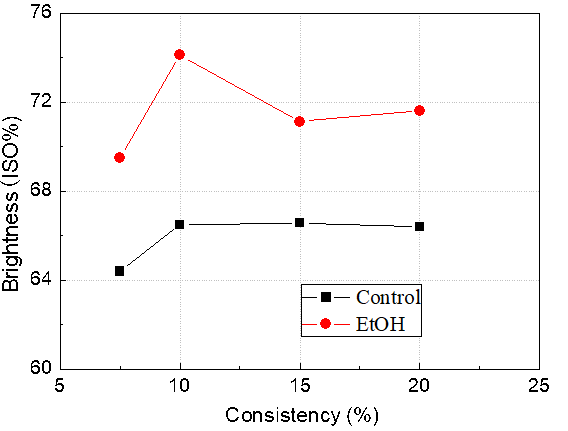
Fig. 2. Optimization of parameters for bleaching conditions: H2O2: 12%, NaOH: 8%, Na2Si2O3: 2%, time:120 min, temperature:95 °C and DTPA: 0.5%, ; Rate of ethanol substitution for water was 70% (m/m– mass to mass)
Then, the brightness remained unchanged until a 20% consistency was achieved for the IEBM method, while pulp brightness remained nearly unchanged in a pulp consistency range of 10 to 20% for the conventional method. It was concluded that a 10% pulp consistency would be ideal for both bleaching medium methods for the later study.
Retention time had a clear effect on the final brightness. As indicated in Fig. 3, bleaching experiments on bamboo CMP pulp were conducted at different retention times with a bleaching temperature of 95 ºC and pulp consistency of 10%. Over a period of 30, 60, 90, 120, and 150 min, a nonlinear dependence of ISO brightness on bleaching time was observed. Pulp brightness was progressively increased with retention time from 30 to 90 min and then increased slowly from 90 to 150 min for both the IEBM and conventional method. After 90 min of bleaching time, brightness levels of 66.2% ISO and 74.0% ISO were obtained for the conventional and IEBM method, respectively.
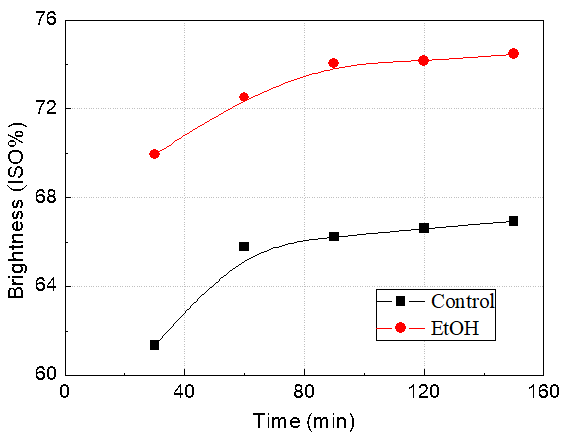
Fig. 3. Optimization of time for bleaching conditions: H2O2: 12%, NaOH: 8%, Na2Si2O3: 2%, temperature: 95 ºC, consistency: 10% and DTPA: 0.5%; Rate of ethanol substitution for water was 70% (m/m– mass to mass)
Another parameter that is important in peroxide bleaching is temperature (Xu 2000b), and it is well known that higher temperatures, in general, increase the rate of bleaching under reasonable conditions (Moldenius and Sjögren 1982). Bleaching experiments on bamboo CMP were conducted at different temperatures with a bleaching time of 120 min and a pulp consistency of 10%. Temperature had a clear effect on the final brightness (Fig. 4). Pulp brightness progressively increased with a temperature increase up to 90 ºC for both the conventional and IEBM method. Brightness continued to increase with temperature from 90 to 95 ºC for the conventional method, while brightness remained nearly unchanged for the IEBM method. When bleached at 95 ºC, brightness levels of 66.6% ISO and 74.4% ISO were obtained for the conventional and IEBM method, respectively.
To investigate the bleaching efficiency of the IEBM method, bleaching conditions were: Na2Si2O3: 2%, DTPA: 0.5%, pulp consistency: 10%, retention time: 90 min, retention temperature: 95 ºC, and rate of ethanol substitution for water was 70% (m/m).
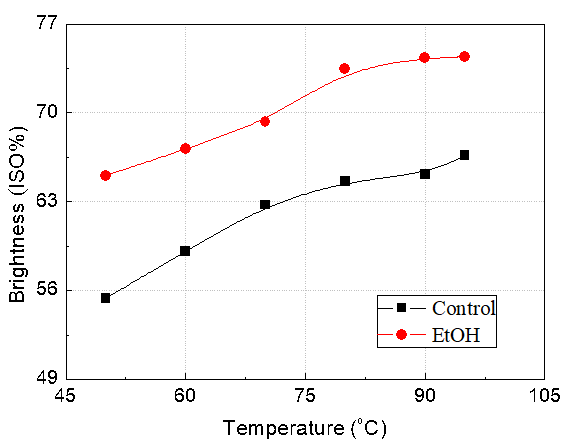
Fig. 4. Optimization of time for bleaching conditions: H2O2: 12%, NaOH: 8%, Na2Si2O3: 2%, consistency: 10%, time 90 min and DTPA: 0.5%; rate of ethanol substitution for water equal to 70% (m/m– mass to mass)
Effect of Alkalinity
Although alkaline conditions are important in peroxide bleaching, literature shows that a higher alkalinity does not always give better bleaching efficiency, and that there is an optimum alkalinity level to achieve the best bleaching efficiency (Xu 2000). In the alkaline conditions, H2O2 decomposes according to Eqs. 1 and 2.
H2O2 + OH- ⇌ HOO- + H2O (1)
H2O2 + HOO- → O2-. + HO. + H2O (2)
The main reactant is HOO- in the hydrogen peroxide bleaching process of mechanical pulp. NaOH can provide OH-, which can increase the rate that H2O2 decomposes as listed in Eq. 1, supply the necessary HOO- for bleaching, neutralization organic acid produced by bleaching process, and swell fiber to improve the strength of the pulp properties. However, the ineffective H2O2 decomposes (Liu 2003) as listed in Eq. 2 and the darkening reaction, which is dominant at higher alkalinity levels, has a negative impact on the bleaching efficiency and the brightness ceiling of mechanical pulp (He et al. 2005). Thus, alkali optimization was necessary for hydrogen peroxide bleaching. Bleaching conditions were: H2O2: 9 to 15%, NaOH: 6 to 14%, Na2Si2O3: 2%, DTPA: 0.5%, pulp consistency: 10%, retention time: 90 min, retention temperature: 95 ºC, and rate of ethanol substitution for water was 70% (m/m).
Alkali optimization was as shown in Fig. 5. The results found were the same as those found in the literature (Shen et al. 2010; Liang et al. 2018), where at a given usage level of H2O2, there was a peak for the brightness of the bleached pulps that indicated the optimal alkali dosage for bleaching. Although the change curve of alkali optimization was different for the conventional and IEBM method, the optimized alkali dosages were the same at the usage level of 9% H2O2 and 15% H2O2 for the two methods, with 8% NaOH and 11% NaOH, respectively. At the level of 12% H2O2, the optimized alkali dosage was 8% for the conventional method, while the optimized alkali dosage was 9% for the IEBM method, but when bleached with 8% and 9% NaOH for the IEBM method, the later brightness was only 0.37% ISO higher than the former. Thus, 8% NaOH was used for the IEBM method at the usage level of 12% H2O2 in the subsequent tests.
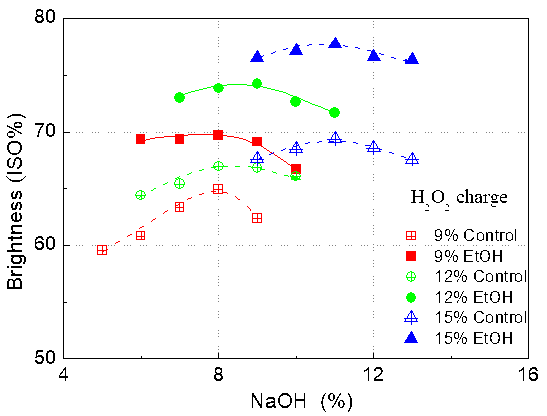
Fig. 5. Alkali optimization
Bleaching Efficiency
Figure 6 shows plots of H2O2 charge versus the pulp brightness with optimized alkalinity usage for both the conventional and IEBM method. Combining the brightness gain and the H2O2 charge leads to an interesting observation that the IEBM method offered a substantially enhanced bleaching efficiency over the conventional method. For a brightness target of 72% ISO, bleaching with the IEBM method reduced the
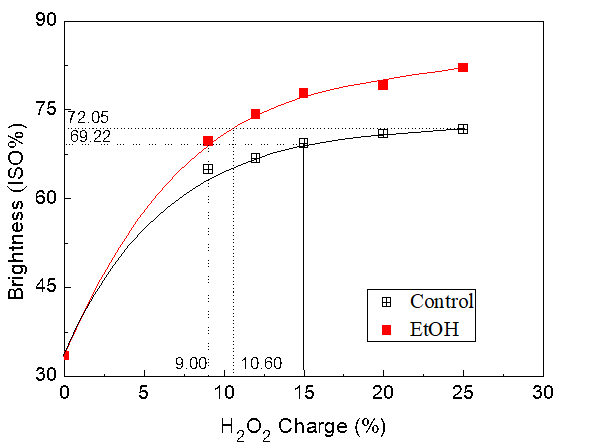
Fig. 6. Improvement of bleaching brightness by the IEBM method
H2O2 consumption by approximately 57.6% compared to the conventional method. It also appears that the bleaching brightness improvement was greater when the pulp was bleached with a higher H2O2 charge. For instance, at the usage level of 9% H2O2, bleaching with the IEBM method resulted in a brightness increase of 4.8% ISO; at the usage level of 15% H2O2 bleaching with the IEBM method resulted in a brightness increase of 8.4% ISO, and at the usage level of 25% H2O2, bleaching with IEBM method resulted in a brightness increase of 10.3% ISO compared to the conventional method.
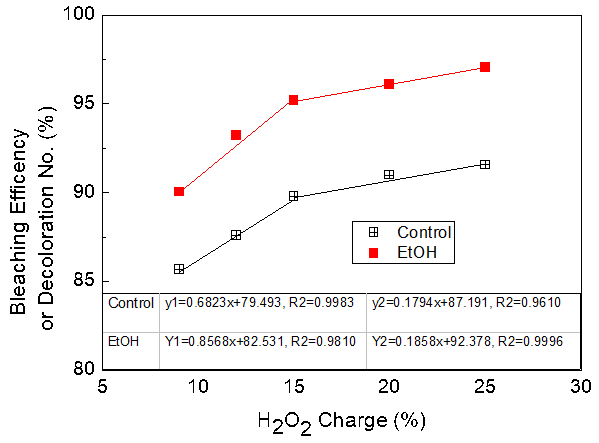
Fig. 7. Improvement of bleaching efficency by the IEBM method
The darkening reaction, which is dominant at higher alkalinity levels, had a negative impact on the bleaching efficiency. This impact is defined as the relative decoloration number (DC) (Loras 1981) according to Eq. 3,
![]()
where k /s for bleached and unbleached pulps is calculated by Eq. 4,

where R∞ is the reflectance factor (the reflectance factor for an opaque pad of the material) (Johansson 2000), k is light-absorption coefficient (m2/kg), and s is light-scattering coefficient (m2/kg)
In the Kubelka-Munk theory, the value of k depends on the chemical composition of the sample, and the value of s depends on the physical structure (Johansson 2000). In bleaching, the color or the light-absorption coefficient (k) is reduced while having little or no effect on the light-scattering coefficient of the pulp (Loras 1981; Johansson 2000). Since DC is the ratio of a change in k /s during bleaching, the change in the light-scattering coefficient and absorption coefficient have been accounted for, thus, the DC number gives an indication of bleaching efficiency (Loras 1981; Mohta et al. 2003).
Figure 7 shows clearly that the relationship between the charge of H2O2 and DC value is divided into two stages during 15% H2O2 charged bleaching at a usage of 15% H2O2. The DC number increased almost linearly for both the IEBM and conventional method, before or after the usage level of 15% H2O2. In the first stage, the DC number increased rapidly with the slope being 0.8568 for the IEBM method, while the slope was 0.6823 for the conventional method. In the second stage, the DC number increased slowly with a slope of 0.1858 for the IEBM method, while the slope was 0.1794 for the conventional method. So, the bleaching efficiency of the IEBM method was higher than that of the conventional method, which can be explained by bleaching brightness improvement being greater when the pulp was bleached with a higher peroxide charge. Moreover, the usage level of 15% H2O2, the bleaching efficiency increased slowly both for the conventional and IEBM method and that is the reason for the bleaching ceiling. Although the IEBM method also had a bleaching ceiling, it was bleached to a brightness of 77.72% ISO at the usage level of 15% H2O2 and increased by 8.36% ISO more than the conventional method. Increasing the amount of H2O2 used to increase brightness is not economical, and thus other methods should be studied to break the bleaching ceiling.
Table 1. Bleaching Experiments for Bamboo CMP Pulp

a: Bamboo CMP pulp without any treatment, b: Bamboo CMP pulp was treated with water before bleaching, time: 90 min, temperature: 95 oC, consistency: 10%, c: Bamboo CMP pulp was treated with EtOH before bleaching, time: 90 min, temperature: 95 oC, consistency: 10%, after being treated, pulp was washed thoroughly, dewatered, and protected at 4oC for further bleaching.
Previous study (Liang et al.2010) has shown that brightness of bamboo SCMP could be improved by 8.9%ISO (with 6% H2O2, 3% NaOH) after extraction by benzyl-alcohol (V:V, 2:1) for 48 h. If brightness improvement for the IEBM method is just caused by the very presence of EtOH acting as a solvent. Experiments have been carried out, and results are listed in Table 1. Treatment with water could improve the brightness by 1.7%ISO, while treatment with EtOH could improve brightness by 2.7%ISO. After treatment, bleaching with a conventional method (9% H2O2, 8% NaOH), treatment with water could improve brightness by 0.3%ISO, while treatment with EtOH could improve it by 1.1%ISO. Furthermore, with the IBEM method of bleaching (9% H2O2, 8% NaOH), treatment with water could improve brightness by 0.5%ISO while treatment with EtOH could improve it by 1.1%ISO. Bleaching with 12%H2O2 achieved nearly the same brightness improvement with 9% H2O2 as treatment with water or EtOH before bleaching. However bleaching with the IEBM method could improve brightness by 4.8%ISO and 7.4%ISO with 9% H2O2 and 12% H2O2 respectively in comparison to the conventional method. That is to say, the mixture of alcohol and water solvent can dissolve some coloured matter, thereby improving the brightness of pulp, but that is not the main reason for the improvement of brightness when employing the IBEM method. The reaction mechanism should be studied in later research, allowing further progress in finding proper methods to reduce bleaching chemical requirements.
Activation Energy
The reactivity of HO-. and O2-. toward aromatic lignin (phenolic structures) is only slightly higher than that with cellulose. Therefore, if H2O2 decomposes too fast and the concentrations of HO-. and O2-. become too high, selectivity toward lignin is lost and cellulose degradation occurs, as well as lignin degradation (Bajpai 2012). In addition, a slow H2O2 decomposition rate will provide a longer duration for pulp exposure to HOO- anions. This can result in better brightening; thus the rate of decomposition of H2O2 into reactive intermediates must be controlled in order to achieve optimal bleaching (Backman and Gellerstedt 1993). Activation energy is used to define the energy barrier to overcome when a chemical reaction occurs and to represent the minimum energy required for a chemical reaction to occur. The chemical reaction rate is closely related to the size of the activation energy. The lower the activation energy is, the faster the reaction speed is. From this discussion, activation energy for the decomposition of H2O2 should be higher to achieve higher brightness and bleaching efficiency.
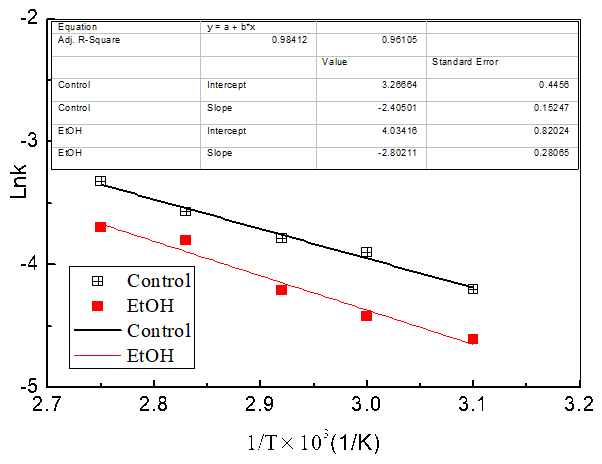
Fig. 8. Dependence of reaction rate on reaction temperature for H2O2 bleaching
Considering a first-order reaction rate for the H2O2 decomposition, the rate constant can be expressed according to the following equation (Levine 2009),
k=2.303/t × log(c0/c) (5)
where k represents the rate constant and has units of the reciprocal of time, t is the reaction time (min), and c0 and c are the initial concentration and the concentration at time t (mg/L), respectively. The rate constant depends strongly on temperature, and in most cases, the rate of decomposition increases with temperature (Barrow 1996). Arrhenius points out that the k(T) data for many reactions fit the expression,
k = Ae-Ea/RT (6)
where A is the preexponential factor, Ea is the Arrhenius activation energy (J/mol or kJ/mol), R is the molar gas constant, 8.314J/(mol·K), and T is the thermodynamic temperature (K). Taking logs of Eq. 6 produces the equation,
ln k = ln A – (Ea/RT) (7)
By plotting the logarithm of the reaction rate against the inverse of the absolute temperature, as shown in Fig. 8, the activation energies Ea for the decomposition of H2O2 both in the IEBM and conventional method were determined. For the IEBM method, the activation energy of H2O2 was calculated to be 23.3 kJ/mol, while the activation energy was calculated to be 20.0 kJ/mol for the conventional method, which agreed with the improvement in brightness and bleaching efficiency when comparing the IEBM and conventional method.
CONCLUSIONS
Bamboo CMP pulps can be bleached by hydrogen peroxide in an aqueous alcoholic medium (IEBM method) to a target brightness with a reduced consumption of bleaching chemicals.
Bleaching using the IEBM method offers substantially enhanced efficiency over the conventional method. In addition, the bleaching brightness improvement was greater when the pulp was bleached with a higher H2O2 usage level.
For the IEBM method, the activation energy of hydrogen peroxide was calculated to be 23.3 kJ/mol, while the activation energy was calculated to be 20.0 kJ/mol for the conventional method, which agrees with the improvement in brightness and bleaching efficiency comparing the IEBM and conventional method
ACKNOWLEDGMENTS
The authors are grateful for the financial support from the National Key Research and Development Projects (2017YFD0601005). The financial support is greatly appreciated.
REFERENCES CITED
Backman, L., and Gellerstedt, G. (1993). “Reactions of kraft pulp with alkaline hydrogen peroxide,” in: Proceedings 7th International Symposium Wood and Pulping Chemistry 1993 Conference, Beijing, China, pp. 240-248.
Barrow, G. M. (1996). Physical Chemistry, McGraw-Hill, New York, NY.
Bajpai, P., Bhardwaj, N.K., Bajpai, P. K., and Jauhari, M. B. (1994). “The impact of xylanases on bleaching of eucalyptus kraft pulp,” Biotechnology 38(1), 1-6. DOI:org/10.1016/0168-1656(94)90141-4
Bajpai, P. (2012). “Hydrogen peroxide bleaching,” in: Environmentally Benign Approaches for Pulp Bleaching (2nd ed.), Elsevier Science Ltd, Amsterdam, Netherlands, pp. 97-134. DOI: 10.1016/B978-0-444-59421-1.00005-3
Chen, B. (2010). “Current status and development of bamboo pulping & papermaking technology,” China Pulp and Paper 29(12), 62-65. DOI: 10.3969/j.issn.0254-508X.2010.12.017
He, Z. B., Ni, Y. H., and Zhang, E. (2005). “Alkaline darkening and its relationship to peroxide bleaching of mechanical pulp,” Journal of Wood Chemistry and Technology 24(1), 1-12. DOI: 10.1081/WCT-120035940
Johansson, M. (2000). Formation of Chromophores and Leucochromophores during Manufacturing of Mechanical Pulp, Licentiate’s Thesis, Royal Institute of Technology Department, Stockholm, Sweden.
Levine, I. N. (2009). Physical Chemistry, McGraw-Hill, New York, N. Y.
Loras, V. (1981). “Pulp and paper,” in: Chemistry and Chemical Technology, J. P. Casey (ed.), Wiley, New York, NY, pp. 633.
Liu, S. J. (2003). “Chemical kinetics of alkaline peroxide brightening of mechanical pulps,” Chemical Engineering Science 58(11), 2229-2244. DOI:10.1016/S0009-2509(03)00089-7
Li, Z. Q., Dou, H. Y., Fu, Y. J., and Qin, M. H. (2015). “Improving the hydrogen peroxide bleaching efficiency of aspen chemithermomechanical pulp by using chitosan,” Carbohydrate Polymers 132(5), 430-436. DOI:org/10.1016/j.carbpol.2015.06.062
Liang, F. M., Fang, G. G., Jiao, J., Deng, Y. J., Han, S. M., Shen, K. Z., Shi, Y. Q., Li, H. B., Zhu, B. P., Pan, A. X., and Tian, Q. W. (2018). “The use of twin screw extruder instead of model screw device during bamboo chemo-mechanical pulping,” BioResources 13(2), 2487-2498. DOI: 10.15376/biores.13.2.2487-2498
Liang, C., Zhan H. Y., Li B. Y., and Fu S. Y. (2010). “Extractives of high-yield bamboo pulp and their effects on H2O2 bleaching,” J. South China Univ. Technol. (Natural Science Edition) 38(9), 46-51.
Moldenius, S., and Sjögren, B. (1982). “Kinetics models for hydrogen peroxide bleaching of mechanical pulps,” Wood Pulp and Paper 2(4), 447-471.
Mohta, D. C., Roy, D. N., and Whiting, P. (2003). “Bleaching study of kenaf mechanical pulps,” Tappi Journal 2(8), 29-32
Ni, Y. H., He, Z. B., and Zhou, Y. J. (2007). “Alkaline peroxide bleaching and the properties of high yield pulp,” Word Pulp and Paper (3), 10-19.
Pan, G. X. (2001). “An insight into the behaviour of aspen CTMP in peroxide bleaching,” Aspen Bibliography 102(11), 41-45. DOI: 10.15376/biores.6.4.4005-4011
Pan, G. X. (2004). “Relationship between dissolution of fiber materials and development of pulp strength in alkaline peroxide bleaching of mechanical pulp,” Holzforschung 58(4), 369-375. DOI: 10.1515/HF.2004.056.
Pan, G. X. (2011). “Improving hydrogen peroxide bleaching of aspen CTMP by using aqueous alcohol media,” BioResources 6(4), 4005-4011.
Shen, K. Z., Fang, G. G., Hu, J. M., Li, P., and Liang, F. M. (2010). “Bleaching of high yield pulps from a bamboo species Neosinocalamus affinis (Rendle) Keng f.,”China Pulp and Paper 29(3), 1-4. DOI: 10.3969/j.issn.0254-508X.2010.03.001
TAPPI T227 om-99 (1999). “Freeness of pulp (Canadian standard method),” TAPPI Press, Atlanta, GA.
TAPPI T452 om-98 (1998). “Brightness of pulp, paper and paperboard (directional reflectance at 457 nm),” TAPPI Press, Atlanta, GA.
Wójciak, A., Kasprzyk, H., Khmelinskii, I., Krawczyk, A., Oliveira, A. S., Ferreira, L. F. V., Birczyńska, A. W., and Sikorsk, M. (2007). “Direct characterization of hydrogen peroxide bleached thermomechanical pulp using spectroscopic methods,” The Journal of Physical Chemistry 111 (42), 10530-10536. DOI: 10.1021/jp074169b
Xu, C. (2000a). “H2O2 bleaching of mechanical pulps. Part I: kinetics and mechanism,” Pulp and Paper Science 26(10), 367-378.
Xu, C. (2000b). “H2O2 bleaching of mechanical pulps. Part 2: pH and temperature,” Pulp and Paper Science 26(11), 407-415
Article submitted: August 3, 2018; October 28, 2018; Revised version received: November 18, 2018; Accepted: November 22, 2018; Published: December 7, 2018.
DOI: 10.15376/biores.14.1.870-881
